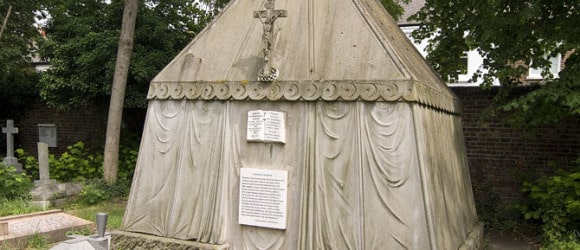A True Story in Stone: Burton Mausoleum
- At May 10, 2013
- By Doug Keister
- In Doug Keister's Blog
0

Tombs and mausoleums often tell a story through the use of statuary, stained glass windows, frieze panels, and architectural embellishments. That story may highlight, among other things, a person’s religious preference, their occupation, and the clubs and societies to which they belonged. However, sometimes, the architectural design of a tomb may tell its own special story.
Such is the case of the mausoleum of British explorer Sir Richard Burton, not to be confused with the actor Sir Richard Burton. Burton is perhaps best known as one of the first non-Muslims to make it to Mecca, and for his translations of The Book of a Thousand Nights and a Night, commonly known as The Arabian Nights, and the Kama Sutra. But, above all, he was a lifelong explorer. His one-of-a-kind mausoleum certainly speaks to his explorations.
The story goes that shortly before Burton’s death he told his wife, Lady Burton (Isabel Arundell), that, after their deaths, he would like them to spend eternity “side-by-side in a tent.” Sir Richard died on October 20th, 1890 of a heart attack in Trieste, in what is now northeastern Italy. He was embalmed shortly thereafter, and Lady Burton got busy designing his mausoleum. The combined cost of the tomb (£460) and the funeral was £668 (approximately $65,000 in today’s dollars). It was funded by public subscription, primarily by his friends. Although the design is often reported to be based on a Bedouin tent, it is in fact based on a tent that the couple used in their travels in Syria, which was constructed so Burton could stand upright when inside.
The exterior of the approximately 11’x12‘x13’ mausoleum is crafted of Forest of Dean sandstone, a particularly hard and fine-grained type of sandstone. The interior floor of the mausoleum is constructed of Carrera marble. The manufacture of the mausoleum has been attributed to Messrs. Dyke, Stonemasons of Highgate (Highgate Cemetery is in London).
Sir Richard was finally laid to rest on June 15, 1891. Lady Burton died five years later on March, 22, 1896.
Indeed, Sir Richard and Lady Burton are essentially lying side-by-side for eternity in a tent, he in a steel casket, and she in a mahogany coffin. Coffins are diamond shaped; caskets are rectangular. Want proof? Sir Richard disliked the dark, so Lady Burton’s design incorporated a window on top of the mausoleum. The window was originally stained glass, but a restoration in the early 1970’s refitted the opening, that had been covered with tin after the stained glass was damaged, with a piece of thick plate glass. A steel ladder was affixed to the outside of the mausoleum to provide visitors access to obtain a clear view of the mausoleum’s interior. Besides the Burtons, the mausoleum interior contains, among other things, an altar, numerous lamps, strings of camel bells, and religious paintings. Near the top of Lady Burton’s coffin is a large battery that supplied current to a “shaker” that rang the camel bells when the door was opened.
The Burton mausoleum is nestled in the tidy St. Mary Magdalen’s churchyard in Mortlake, formerly a suburb southwest of London, but now engulfed in the London megalopolis. It is truly a story in stone.
Text and photograph © Douglas Keister Visit Doug’s Author Page.
DKeister
